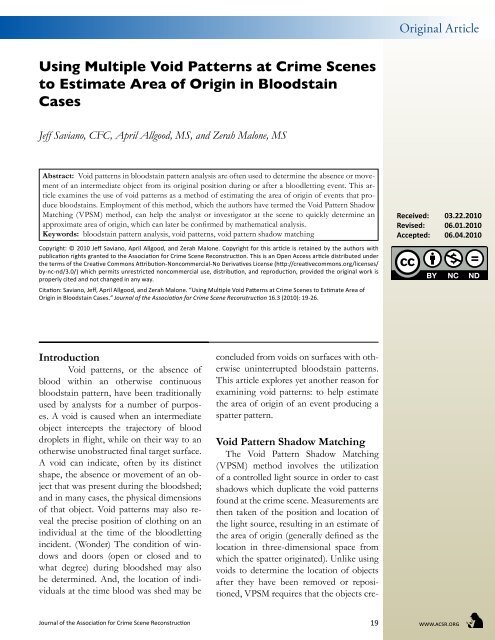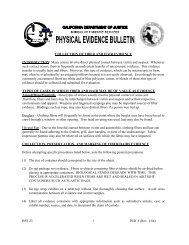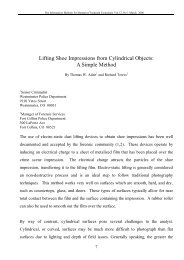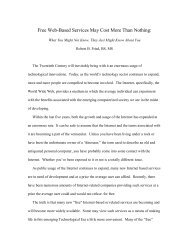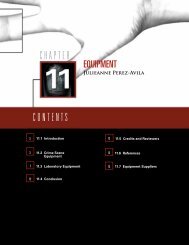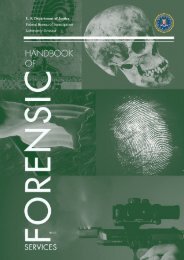Using Multiple Void Patterns at Crime Scenes to Estimate Area of ...
Using Multiple Void Patterns at Crime Scenes to Estimate Area of ...
Using Multiple Void Patterns at Crime Scenes to Estimate Area of ...
Create successful ePaper yourself
Turn your PDF publications into a flip-book with our unique Google optimized e-Paper software.
Article<br />
Original Article<br />
Original Articles<br />
<strong>Using</strong> <strong>Multiple</strong> <strong>Void</strong> <strong>P<strong>at</strong>terns</strong> <strong>at</strong> <strong>Crime</strong> <strong>Scenes</strong><br />
<strong>to</strong> Estim<strong>at</strong>e <strong>Area</strong> <strong>of</strong> Origin in Bloodstain<br />
Cases<br />
Jeff Saviano, CFC, April Allgood, MS, and Zerah Malone, MS<br />
Abstract: <strong>Void</strong> p<strong>at</strong>terns in bloodstain p<strong>at</strong>tern analysis are <strong>of</strong>ten used <strong>to</strong> determine the absence or movement<br />
<strong>of</strong> an intermedi<strong>at</strong>e object from its original position during or after a bloodletting event. This article<br />
examines the use <strong>of</strong> void p<strong>at</strong>terns as a method <strong>of</strong> estim<strong>at</strong>ing the area <strong>of</strong> origin <strong>of</strong> events th<strong>at</strong> produce<br />
bloodstains. Employment <strong>of</strong> this method, which the authors have termed the <strong>Void</strong> P<strong>at</strong>tern Shadow<br />
M<strong>at</strong>ching (VPSM) method, can help the analyst or investig<strong>at</strong>or <strong>at</strong> the scene <strong>to</strong> quickly determine an<br />
approxim<strong>at</strong>e area <strong>of</strong> origin, which can l<strong>at</strong>er be confirmed by m<strong>at</strong>hem<strong>at</strong>ical analysis.<br />
Keywords: bloodstain p<strong>at</strong>tern analysis, void p<strong>at</strong>terns, void p<strong>at</strong>tern shadow m<strong>at</strong>ching<br />
Copyright: © 2010 Jeff Saviano, April Allgood, and Zerah Malone. Copyright for this article is retained by the authors with<br />
public<strong>at</strong>ion rights granted <strong>to</strong> the Associ<strong>at</strong>ion for <strong>Crime</strong> Scene Reconstruction. This is an Open Access article distributed under<br />
the terms <strong>of</strong> the Cre<strong>at</strong>ive Commons Attribution-Noncommercial-No Deriv<strong>at</strong>ives License (http://cre<strong>at</strong>ivecommons.org/licenses/<br />
by-nc-nd/3.0/) which permits unrestricted noncommercial use, distribution, and reproduction, provided the original work is<br />
properly cited and not changed in any way.<br />
Cit<strong>at</strong>ion: Saviano, Jeff, April Allgood, and Zerah Malone. “<strong>Using</strong> <strong>Multiple</strong> <strong>Void</strong> <strong>P<strong>at</strong>terns</strong> <strong>at</strong> <strong>Crime</strong> <strong>Scenes</strong> <strong>to</strong> Estim<strong>at</strong>e <strong>Area</strong> <strong>of</strong><br />
Origin in Bloodstain Cases.” Journal <strong>of</strong> the Associ<strong>at</strong>ion for <strong>Crime</strong> Scene Reconstruction 16.3 (2010): 19-26.<br />
Introduction<br />
<strong>Void</strong> p<strong>at</strong>terns, or the absence <strong>of</strong><br />
blood within an otherwise continuous<br />
bloodstain p<strong>at</strong>tern, have been traditionally<br />
used by analysts for a number <strong>of</strong> purposes.<br />
A void is caused when an intermedi<strong>at</strong>e<br />
object intercepts the trajec<strong>to</strong>ry <strong>of</strong> blood<br />
droplets in flight, while on their way <strong>to</strong> an<br />
otherwise unobstructed final target surface.<br />
A void can indic<strong>at</strong>e, <strong>of</strong>ten by its distinct<br />
shape, the absence or movement <strong>of</strong> an object<br />
th<strong>at</strong> was present during the bloodshed;<br />
and in many cases, the physical dimensions<br />
<strong>of</strong> th<strong>at</strong> object. <strong>Void</strong> p<strong>at</strong>terns may also reveal<br />
the precise position <strong>of</strong> clothing on an<br />
individual <strong>at</strong> the time <strong>of</strong> the bloodletting<br />
incident. (Wonder) The condition <strong>of</strong> windows<br />
and doors (open or closed and <strong>to</strong><br />
wh<strong>at</strong> degree) during bloodshed may also<br />
be determined. And, the loc<strong>at</strong>ion <strong>of</strong> individuals<br />
<strong>at</strong> the time blood was shed may be<br />
concluded from voids on surfaces with otherwise<br />
uninterrupted bloodstain p<strong>at</strong>terns.<br />
This article explores yet another reason for<br />
examining void p<strong>at</strong>terns: <strong>to</strong> help estim<strong>at</strong>e<br />
the area <strong>of</strong> origin <strong>of</strong> an event producing a<br />
sp<strong>at</strong>ter p<strong>at</strong>tern.<br />
<strong>Void</strong> P<strong>at</strong>tern Shadow M<strong>at</strong>ching<br />
The <strong>Void</strong> P<strong>at</strong>tern Shadow M<strong>at</strong>ching<br />
(VPSM) method involves the utiliz<strong>at</strong>ion<br />
<strong>of</strong> a controlled light source in order <strong>to</strong> cast<br />
shadows which duplic<strong>at</strong>e the void p<strong>at</strong>terns<br />
found <strong>at</strong> the crime scene. Measurements are<br />
then taken <strong>of</strong> the position and loc<strong>at</strong>ion <strong>of</strong><br />
the light source, resulting in an estim<strong>at</strong>e <strong>of</strong><br />
the area <strong>of</strong> origin (generally defined as the<br />
loc<strong>at</strong>ion in three-dimensional space from<br />
which the sp<strong>at</strong>ter origin<strong>at</strong>ed). Unlike using<br />
voids <strong>to</strong> determine the loc<strong>at</strong>ion <strong>of</strong> objects<br />
after they have been removed or repositioned,<br />
VPSM requires th<strong>at</strong> the objects cre-<br />
Received: 03.22.2010<br />
Revised: 06.01.2010<br />
Accepted: 06.04.2010<br />
Journal <strong>of</strong> the Associ<strong>at</strong>ion for <strong>Crime</strong> Scene Reconstruction 19<br />
www.acsr.org
Figure 1: This scene, in<br />
which objects and structures<br />
<strong>of</strong> varying dimensions<br />
are found in different<br />
loc<strong>at</strong>ions and on different<br />
geometric planes, lends<br />
itself <strong>to</strong> the use <strong>of</strong> the<br />
VPSM method for estim<strong>at</strong>ing<br />
area <strong>of</strong> origin.<br />
Figure 2a (left): A void p<strong>at</strong>tern<br />
is loc<strong>at</strong>ed above and<br />
<strong>to</strong> the right <strong>of</strong> the electrical<br />
receptacle.<br />
Figure 2b (right): The void<br />
p<strong>at</strong>tern from Figure 2a is<br />
outlined in red.<br />
www.acsr.org<br />
<br />
<br />
<strong>at</strong>ing the voids be present in their original<br />
positions.<br />
Theoretically, VPSM could be used with<br />
a single void p<strong>at</strong>tern <strong>at</strong> a scene; however,<br />
the precision and accuracy <strong>of</strong> the method<br />
is gre<strong>at</strong>ly increased when multiple void<br />
p<strong>at</strong>terns, occurring on separ<strong>at</strong>e geometric<br />
planes, are present. Due <strong>to</strong> this observ<strong>at</strong>ion,<br />
the more complex the physical aspects<br />
<strong>of</strong> the scene are, the better results will be<br />
obtained using VPSM. Figure 1 is an example<br />
<strong>of</strong> one type <strong>of</strong> complex scene in<br />
which VPSM could be used <strong>to</strong> benefit the<br />
scene investig<strong>at</strong>or or analyst. Note th<strong>at</strong> the<br />
scene contains numerous objects <strong>of</strong> different<br />
shapes and dimensions. Note, also, th<strong>at</strong><br />
the objects are loc<strong>at</strong>ed on several different<br />
geometric planes in rel<strong>at</strong>ion <strong>to</strong> the overall<br />
scene. As such, sp<strong>at</strong>ter from a single blood<br />
source impacts only the exposed surface<br />
<strong>of</strong> each <strong>of</strong> the objects and cre<strong>at</strong>es multiple<br />
void p<strong>at</strong>terns behind them.<br />
20<br />
Figures 2a and 2b are from the same<br />
crime scene as Figure 1. In this example the<br />
electrical outlet has served as an intermedi<strong>at</strong>e<br />
target producing a void p<strong>at</strong>tern on the<br />
wall behind it (illustr<strong>at</strong>ed by the rectangular<br />
outline in Figure 2b). The loc<strong>at</strong>ion <strong>of</strong> the<br />
void (above and <strong>to</strong> the right <strong>of</strong> the receptacle)<br />
should suggest <strong>to</strong> the analyst th<strong>at</strong> the<br />
source <strong>of</strong> the blood was, in general terms,<br />
below and <strong>to</strong> the left <strong>of</strong> the outlet as pictured.<br />
The use <strong>of</strong> VPSM would provide the<br />
analyst <strong>at</strong> the scene with a much more precise<br />
assessment <strong>of</strong> th<strong>at</strong> area <strong>of</strong> origin.<br />
Methods and M<strong>at</strong>erials<br />
To explore the potential efficacy <strong>of</strong> the<br />
<strong>Void</strong> P<strong>at</strong>tern Shadow M<strong>at</strong>ching method,<br />
the authors cre<strong>at</strong>ed a simul<strong>at</strong>ed crime scene<br />
with a target area consisting <strong>of</strong> a plastic<br />
shelving unit with three shelves, various<br />
household objects placed arbitrarily on the<br />
shelves, and a wall which was covered with<br />
white poster board and loc<strong>at</strong>ed behind the<br />
shelving unit. A sponge was affixed <strong>to</strong> a<br />
stack <strong>of</strong> cinder blocks and positioned approxim<strong>at</strong>ely<br />
28 inches (71 cm) from the<br />
back wall and approxim<strong>at</strong>ely 34 inches (86<br />
cm) above the floor (see Figure 3). Medium<br />
energy impact sp<strong>at</strong>ter was then gener<strong>at</strong>ed<br />
by striking the blood-soaked sponge with a<br />
rubber mallet. Once the impact sp<strong>at</strong>ter was<br />
cre<strong>at</strong>ed, the sponge and cinder blocks were<br />
removed so th<strong>at</strong> the authors could examine<br />
the sp<strong>at</strong>ter and void p<strong>at</strong>terns.<br />
Volume 16, Issue 3, Summer 2010
Figure 3: Setup <strong>of</strong> simul<strong>at</strong>ed<br />
crime scene used for<br />
testing the VPSM method.<br />
Journal <strong>of</strong> the Associ<strong>at</strong>ion for <strong>Crime</strong> Scene Reconstruction 21<br />
www.acsr.org
Figure 4: One <strong>of</strong> the authors<br />
using a floodlight<br />
with reflec<strong>to</strong>r as a light<br />
source for cre<strong>at</strong>ing shadows<br />
within the target<br />
area.<br />
www.acsr.org<br />
<br />
Figure 5: <strong>Multiple</strong> void<br />
p<strong>at</strong>terns, which were<br />
caused by both the upper<br />
shelf and the Triscuit®<br />
box, are shown <strong>to</strong> correspond<br />
with shadows<br />
cre<strong>at</strong>ed within the target<br />
area by use <strong>of</strong> the small<br />
LED flashlight.<br />
<br />
22<br />
Volume 16, Issue 3, Summer 2010
Pursuant <strong>to</strong> the VPSM method, various<br />
portable light sources were utilized in order<br />
<strong>to</strong> cre<strong>at</strong>e shadows within the target area.<br />
The authors employed a floodlight with reflec<strong>to</strong>r<br />
(see Figure 4), a hand lantern with a<br />
6V block b<strong>at</strong>tery, and a small LED flashlight.<br />
All three methods produced s<strong>at</strong>isfac<strong>to</strong>ry<br />
results; however, it was found th<strong>at</strong> the<br />
more focused light from the LED flashlight<br />
produced shadows th<strong>at</strong> were better defined<br />
and, therefore, easier <strong>to</strong> m<strong>at</strong>ch <strong>to</strong> the void<br />
p<strong>at</strong>terns.<br />
The light source was moved about the<br />
scene until the light cast shadows which duplic<strong>at</strong>ed<br />
the outline <strong>of</strong> the void p<strong>at</strong>terns cre<strong>at</strong>ed<br />
by both the household objects and the<br />
shelving unit on which they were placed.<br />
In adjusting the position <strong>of</strong> the light, effort<br />
was made <strong>to</strong> duplic<strong>at</strong>e multiple void p<strong>at</strong>terns<br />
simultaneously. In order <strong>to</strong> achieve<br />
the gre<strong>at</strong>est accuracy, one <strong>of</strong> the authors<br />
controlled the light source, while the other<br />
two (with full view <strong>of</strong> the target area) provided<br />
guidance regarding the positioning<br />
<strong>of</strong> the light. It should be noted, also, th<strong>at</strong> all<br />
room lights were extinguished during the<br />
process in order <strong>to</strong> avoid any extraneous<br />
shadows caused by lighting other than the<br />
intended light sources.<br />
Figures 5a and 5b illustr<strong>at</strong>e shadows<br />
m<strong>at</strong>ching void p<strong>at</strong>terns in one portion <strong>of</strong><br />
the target area. Note th<strong>at</strong> the edge <strong>of</strong> the<br />
upper shelf cre<strong>at</strong>es a void on the wall behind<br />
it; and <strong>at</strong> the same time, the Triscuit®<br />
Figure 5b: Red outlines illustr<strong>at</strong>e<br />
the void p<strong>at</strong>terns<br />
and corresponding shadows<br />
from Figure 5a.<br />
Journal <strong>of</strong> the Associ<strong>at</strong>ion for <strong>Crime</strong> Scene Reconstruction 23<br />
www.acsr.org
www.acsr.org<br />
box cre<strong>at</strong>es a void on the shelf on which<br />
it sits, as well as on the wall. In m<strong>at</strong>ching<br />
these multiple void p<strong>at</strong>terns on more than<br />
one geometric plane, VPSM allowed the final<br />
position <strong>of</strong> the light source within the<br />
scene <strong>to</strong> replic<strong>at</strong>e the original position <strong>of</strong><br />
the blood-soaked sponge, which was above<br />
and <strong>to</strong> the right <strong>of</strong> the Triscuit® box. Once<br />
the precise position <strong>of</strong> the light source was<br />
obtained, three measurements were taken<br />
<strong>to</strong> document the x, y, and z coordin<strong>at</strong>es <strong>of</strong><br />
the light source within the scene, thus determining<br />
the area <strong>of</strong> origin for the sp<strong>at</strong>ter.<br />
In this experiment, these measurements<br />
indic<strong>at</strong>ed th<strong>at</strong> the x and y (horizontal) coordin<strong>at</strong>es<br />
corresponded <strong>to</strong> those <strong>of</strong> the<br />
original measured position <strong>of</strong> the bloodsoaked<br />
sponge. The z coordin<strong>at</strong>e <strong>of</strong> the<br />
light source was found <strong>to</strong> be three inches<br />
(approxim<strong>at</strong>ely 7.6 cm) above the original<br />
position <strong>of</strong> the sponge. This discrepancy<br />
in the vertical measurement was not found<br />
<strong>to</strong> be problem<strong>at</strong>ic, taking in<strong>to</strong> account the<br />
parabolic arc <strong>of</strong> the blood droplets in flight.<br />
Valid<strong>at</strong>ion <strong>of</strong> Results<br />
Once the area <strong>of</strong> origin was determined<br />
using the VPSM method, the authors recalcul<strong>at</strong>ed<br />
the area <strong>of</strong> origin employing methods<br />
currently in use by bloodstain p<strong>at</strong>tern<br />
analysts: stringing; m<strong>at</strong>hem<strong>at</strong>ical calcul<strong>at</strong>ions<br />
(tangent method); and computer-aided<br />
analysis (BackTrack). In utilizing these<br />
methods, the authors documented the position<br />
and impact angles <strong>of</strong> 10 well-formed<br />
stains, chosen from various loc<strong>at</strong>ions on<br />
the poster board. All three traditional<br />
methods gave results th<strong>at</strong> were within four<br />
inches (approxim<strong>at</strong>ely 10 cm) <strong>of</strong> the known<br />
loc<strong>at</strong>ion <strong>of</strong> the blood source. Interestingly,<br />
the three traditional methods each gave results<br />
th<strong>at</strong> devi<strong>at</strong>ed slightly on the horizontal<br />
plane, while the VPSM method showed no<br />
such devi<strong>at</strong>ion.<br />
Conclusions<br />
The <strong>Void</strong> P<strong>at</strong>tern Shadow M<strong>at</strong>ching<br />
(VPSM) method <strong>of</strong> determining area<br />
24<br />
<strong>of</strong> origin proved <strong>to</strong> be just as accur<strong>at</strong>e (if<br />
not slightly more so) as the currently used<br />
methods <strong>of</strong> stringing, m<strong>at</strong>hem<strong>at</strong>ical calcul<strong>at</strong>ion,<br />
and computer-aided analysis. It<br />
should be noted here, however, th<strong>at</strong> unlike<br />
the traditional methods, VPSM requires<br />
no m<strong>at</strong>hem<strong>at</strong>ical calcul<strong>at</strong>ions other than<br />
measurements <strong>of</strong> the final position <strong>of</strong> the<br />
light source. Therefore, the additional human<br />
measurement and calcul<strong>at</strong>ion fac<strong>to</strong>rs<br />
involved in the traditional methods (measuring<br />
the short and long axes <strong>of</strong> the stains,<br />
calcul<strong>at</strong>ing angles <strong>of</strong> impact, determining<br />
gamma angles, and physically stringing the<br />
blood droplets’ flight p<strong>at</strong>hs), are likely the<br />
sources <strong>of</strong> the (perceived) increase in accuracy<br />
<strong>of</strong> VPSM over the other methods.<br />
Furthermore, although the precision <strong>of</strong> the<br />
measurements in this experiment were documented<br />
in some cases <strong>to</strong> two decimal places,<br />
the area <strong>of</strong> origin derived by any <strong>of</strong> the<br />
four methods would have been reported as<br />
approxim<strong>at</strong>ions or a dimensional range in<br />
actual casework. As such, it could be said<br />
th<strong>at</strong> all four methods returned results th<strong>at</strong><br />
were analogous <strong>to</strong> one another.<br />
The advantages <strong>of</strong> using the VPSM<br />
method are several. First, VPSM provides a<br />
quick and accur<strong>at</strong>e altern<strong>at</strong>ive <strong>to</strong> traditional<br />
methods, and can be used <strong>to</strong> easily estim<strong>at</strong>e<br />
the area <strong>of</strong> origin <strong>of</strong> impact sp<strong>at</strong>ter while the<br />
crime scene is still being processed. In this<br />
way it can be an investig<strong>at</strong>ive <strong>to</strong>ol th<strong>at</strong> may<br />
be helpful in further evalu<strong>at</strong>ing the scene,<br />
or in interviewing witnesses and suspects.<br />
The method requires no equipment other<br />
than a light source (e.g. an LED flashlight)<br />
and a tape measure; thus, it is easily accessible<br />
<strong>to</strong> any crime scene investig<strong>at</strong>or with a<br />
rudimentary knowledge <strong>of</strong> bloodstain p<strong>at</strong>tern<br />
analysis. The final target surface is less<br />
critical with VPSM than it is with traditional<br />
methods, since the analyst is only identifying<br />
void p<strong>at</strong>terns and not looking for a<br />
sufficient number <strong>of</strong> well-formed stains <strong>to</strong><br />
use for impact angle calcul<strong>at</strong>ions. Finally,<br />
VPSM requires fewer measurements than<br />
Volume 16, Issue 3, Summer 2010
the traditional methods; therefore, reducing<br />
the likelihood <strong>of</strong> human error. It has been<br />
shown, for example, th<strong>at</strong> measurement error,<br />
particularly regarding stains th<strong>at</strong> have<br />
impacted the target surface <strong>at</strong> angles gre<strong>at</strong>er<br />
than 50 degrees, can result in a fairly large<br />
discrepancy in calcul<strong>at</strong>ed impact angles.<br />
(Pace)<br />
Discussion<br />
The authors see the <strong>Void</strong> P<strong>at</strong>tern Shadow<br />
M<strong>at</strong>ching method as an investig<strong>at</strong>ive <strong>to</strong>ol,<br />
which can provide the analyst or investig<strong>at</strong>or<br />
with immedi<strong>at</strong>e results <strong>at</strong> the crime<br />
scene. It’s important <strong>to</strong> note, however,<br />
th<strong>at</strong> a competent and experienced bloodstain<br />
p<strong>at</strong>tern analyst, using one or more <strong>of</strong><br />
the traditional methods, should verify the<br />
VPSM results before testimony is given in a<br />
court proceeding, particularly if the VPSM<br />
method was used by someone other than<br />
a court-qualified expert in bloodstain p<strong>at</strong>tern<br />
analysis. To th<strong>at</strong> end, the scene and<br />
the bloodstain p<strong>at</strong>terns should still be thoroughly<br />
documented <strong>to</strong> such a degree th<strong>at</strong> a<br />
traditional bloodstain p<strong>at</strong>tern analysis can<br />
be performed.<br />
The authors feel th<strong>at</strong> additional experiment<strong>at</strong>ion<br />
with VPSM is warranted and<br />
should be carried out by independent researchers.<br />
Included among the goals <strong>of</strong><br />
further research would be the explor<strong>at</strong>ion<br />
<strong>of</strong> the effects <strong>of</strong> two different variables: the<br />
distance between the object cre<strong>at</strong>ing the<br />
void p<strong>at</strong>tern and the surface on which the<br />
void p<strong>at</strong>tern is found; and the distance between<br />
the blood source and the void-cre<strong>at</strong>ing<br />
intervening target(s). It is hypothesized<br />
by the authors th<strong>at</strong> the closer the void-cre<strong>at</strong>ing<br />
object is <strong>to</strong> the target surface containing<br />
the void p<strong>at</strong>tern, the sharper will be the<br />
deline<strong>at</strong>ion <strong>of</strong> the void itself. Therefore, it<br />
should be easier <strong>to</strong> visualize the correspondence<br />
between the void and the shadow in<br />
cases where the intermedi<strong>at</strong>e target is closest<br />
<strong>to</strong> the target surface containing the void.<br />
It is further hypothesized th<strong>at</strong> the farther<br />
the blood source is from the target area, the<br />
less accur<strong>at</strong>e the area <strong>of</strong> origin will be. This<br />
is based on consider<strong>at</strong>ion <strong>of</strong> the parabolic<br />
arc described by each <strong>of</strong> the blood droplets.<br />
Blood droplets <strong>of</strong> similar volume and mass,<br />
which travel a farther distance without being<br />
intercepted by an intermedi<strong>at</strong>e target<br />
(thus, spending more time in the air) are expected<br />
<strong>to</strong> be more susceptible <strong>to</strong> redirection<br />
by the forces <strong>of</strong> gravity and air resistance<br />
than those traveling a shorter distance for<br />
a shorter period <strong>of</strong> time. (James) Depending<br />
on the length <strong>of</strong> the flight p<strong>at</strong>h, the final<br />
segment <strong>of</strong> the blood droplet’s course<br />
may be sharply downward, which is likely<br />
<strong>to</strong> affect the position and dimensions <strong>of</strong><br />
the void p<strong>at</strong>tern. Therefore, in cases where<br />
the blood source is a considerable distance<br />
from the target area, two phenomena would<br />
be expected <strong>to</strong> occur. First, the void p<strong>at</strong>terns<br />
themselves would be less deline<strong>at</strong>ed<br />
and more diffuse—a phenomenon caused<br />
by the arc <strong>of</strong> some <strong>of</strong> the blood droplets allowing<br />
them <strong>to</strong> clear the intermedi<strong>at</strong>e target<br />
and strike the final target surface <strong>at</strong> points<br />
th<strong>at</strong> would otherwise be devoid <strong>of</strong> blood.<br />
Second, the area <strong>of</strong> origin determined by<br />
VPSM would be expected <strong>to</strong> be higher<br />
(have an increased z coordin<strong>at</strong>e) than the<br />
original position <strong>of</strong> the actual blood source.<br />
In the methodology used for this article,<br />
all three authors were aware <strong>of</strong> the loc<strong>at</strong>ion<br />
<strong>of</strong> the blood source prior <strong>to</strong> the utiliz<strong>at</strong>ion<br />
<strong>of</strong> the VPSM method for finding the area<br />
<strong>of</strong> origin. Future experiment<strong>at</strong>ion and valid<strong>at</strong>ion<br />
studies should include a blind procedure<br />
in which one or more analysts would<br />
not be present during the deposition <strong>of</strong> the<br />
blood and cre<strong>at</strong>ion <strong>of</strong> the void p<strong>at</strong>terns. In<br />
such a scenario the blood source would be<br />
removed prior <strong>to</strong> the VPSM analysis and<br />
subsequent verific<strong>at</strong>ion by traditional methods,<br />
and the results <strong>of</strong> the analyses would<br />
be checked against the known loc<strong>at</strong>ion <strong>of</strong><br />
the blood source.<br />
Journal <strong>of</strong> the Associ<strong>at</strong>ion for <strong>Crime</strong> Scene Reconstruction 25<br />
www.acsr.org
www.acsr.org<br />
Finally, although the blood source as<br />
found by the VPSM method can be documented<br />
simply by the use <strong>of</strong> a tape measure<br />
and thorough note taking, future research<br />
might include a method for pho<strong>to</strong>graphically<br />
documenting the VPSM analysis. Ambient<br />
light pho<strong>to</strong>graphs might be considered<br />
in which the camera would be placed on a<br />
tripod and positioned, for example, behind<br />
the light source (perpendicular <strong>to</strong> the target<br />
area), as well as <strong>to</strong> the side <strong>of</strong> the light<br />
source (parallel <strong>to</strong> the target area) in order<br />
<strong>to</strong> document the loc<strong>at</strong>ion <strong>of</strong> the blood<br />
source as determined by VPSM. This research<br />
could also include recommend<strong>at</strong>ions<br />
for camera and lens types, as well as for exposure<br />
settings.<br />
Certainly, not all crime scenes will lend<br />
themselves <strong>to</strong> the VPSM method. The analyst<br />
or investig<strong>at</strong>or will have <strong>to</strong> evalu<strong>at</strong>e<br />
each scene <strong>to</strong> determine if VPSM will be <strong>of</strong><br />
benefit <strong>to</strong> the investig<strong>at</strong>ion. In the future,<br />
with adequ<strong>at</strong>e valid<strong>at</strong>ion, VPSM may, in<br />
some circumstances, be able <strong>to</strong> replace one<br />
or more <strong>of</strong> the traditional methods <strong>of</strong> determining<br />
area <strong>of</strong> origin. For now, however,<br />
in cases where the physical aspects and<br />
configur<strong>at</strong>ion <strong>of</strong> the scene suggest th<strong>at</strong> this<br />
type <strong>of</strong> analysis would be beneficial, VPSM<br />
can serve as a useful addition <strong>to</strong> the crime<br />
scene investig<strong>at</strong>or’s analytic <strong>to</strong>olbox.<br />
References<br />
James, Stuart H., Paul E. Kish, and T.<br />
Paulette Sut<strong>to</strong>n. Principles <strong>of</strong> Bloodstain P<strong>at</strong>tern<br />
Analysis Theory and Practice. Boca R<strong>at</strong>on:<br />
CRC Press, 2005.<br />
Pace, Alexi. “The Rel<strong>at</strong>ionship Between<br />
Errors in Ellipse Fitting and the Increasing<br />
Degree <strong>of</strong> Error in Angle <strong>of</strong> Impact Calcul<strong>at</strong>ions.”<br />
IABPA News, September 2005:<br />
pages 12–14.<br />
Wonder, Anita. Blood Dynamics. San Diego:<br />
Academic Press, 2001.<br />
26<br />
Volume 16, Issue 3, Summer 2010


